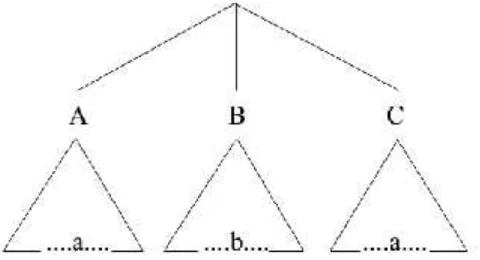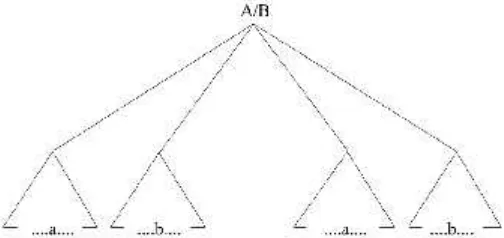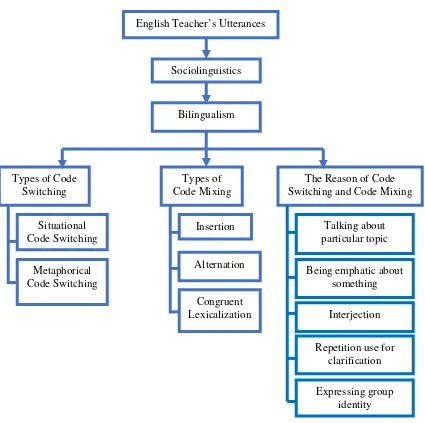6
This chapter explains about review of related literature of the research which is divided into three parts. They are theoretical description, previous studies, and conceptual framework.
2.1 Theoretical Description
This part consists of description should be explained in the research. There are sociolinguistics as the root of the research, bilingual as sub of sociolinguistics, code switching and code mixing as the main discussion of the research.
2.1.1 Sociolinguistics
Sociolinguistics is the branch of linguistics. Holmes (2012) states that “sociolinguistics study the relationship between language and society”. Sociolinguistics identify the language used by human in delivering their message to other groups of society. In addition, sociolinguistics give advice for others to know with whom they are talking to. In line with it, Wardaugh (2006) states that sociolinguistics is the study of language in a group of speakers.
2.1.2 Bilingual
In communication, most of the people as a speaker are able to speak in more than one language, this phenomenon called bilingual. Myres-Scotton (20016) states that bilingual is speaking in one or more languages. In Indonesia, the language is divided into three; mother tongue as a first language, Indonesia language as a second language; and English as a foreign language. Thus, in the communication people combine the speech by using more than one language. A person who is bilingual have a good skill in those alternated languages. Moreover, a bilingual should have the ability to sense and define the situation in which she should make the switch from one language to another and then to do so fluently for various kinds of purposes, in various kinds of situation. This condition may lead them to do the code switching and code mixing.
2.1.3 Code Switching
single speaker’s turn.” He also adds that code switching “can occur between sentences (intersententially) or within a single sentence (intrasententially).”
Fromkin et.al. (2014) has his own definition about code switching. He states that code switching is “the movement back and forth between two languages or dialects within the same sentence or discourse.” He points out about code switching which people change the language in a single sentence. In line with it, Meyerhoff (2006) states that code switching “in its most specific sense, the alternation between varieties, or codes, across sentences or clause boundaries.” Code switching happens when a speaker uses alternation language when they speak.
It can be concluded that code switching is the changing of speech in a single sentence using alternative languages. In addition, people who are able to speak in more than one language use code switching to maintain misunderstanding perception.
2.1.3.1 The Types of Code Switching
Experts have their own idea in describing the types of code switching. The researcher uses the theory of Holmes (2012) in describing the types of code switching. He states that there are two types of code switching; they are situational code switching and metaphorical code switching.
1. Situational Code Switching
The first type of code switching is situational code switching. It occurs when people switch one language into another language in a single sentence. It can be identified based on the reason of the speaker and when he/she have to change the language.
Example:
Teacher:Uculisweatere!are you ok?(Please took of your sweater! Are you OK? Students: Ok, pak(OK, Sir)
Teacher: Kecuali yang sakit, ya! Kecuali yang sakit. OK! Let me call you first. (The one who are sick are allow to wear jacket. OK! Let me call you first.
2. Metaphorical Code Switching
The second types of code switching by Holmes (2014) is metaphorical code switching. Metaphorical code switching occurs when a speaker changes the languages when they change the topic. For example, English teacher uses English when he/she teaches English, then change into another language when he/she in the teacher's room, or other places. The special case is when the English teacher teaches in class, then other students, another teacher, or other school staff comes because of some purposes.
Example:
Teacher: OK! Are you ready?(OK! Are you ready)? Students: Yes, Sir!(Yes, Sir!)
Teacher: This morning, we are going to learnteksrecount.Teksrecount is….(This morning, we are going to learn recount text. Recount text is)
Students from another class call one of the members of the class Students: Assalamu’alaikum Pak.(Assalamu’alaikum, Sir.)
Teacher: Wa’alaikum Salam.(Wa’alaikum Salam).
Students: Mau manggil…. mau manggil Iqna Pak! (We are going to meet Iqna, Sir!)
Teacher:Oh yeah! Iqna!(Oh, yes! Iqna)
(Recorded in March, 2017) In the conversation, teacher and students started to learn English, then other students from another class come to call one of the members. The teacher uses Indonesia language to communicate with the students because the topic is different. The teacher uses English because he teaches English, then he changes into Indonesia language because he talks about another topic with different students.
2.1.4 Code Mixing
2.1.4.1 They Type of Code Mixing
Muysken (in Deuchar, 2005) states that the type of code mixing is divided into three, they are inserted, alternation, and congruent lexicalization.
1. Insertion
In the insertion, one language determines the overall structure into which constituents from the other language are inserted. The conversation consists of two languages which one of the language among other languages. The illustration is below. A, B, and C for non-terminal nodes (i.e. fictitious markers identifying entire constituents as belonging to one language), then a and b labelled for terminal, i.e. lexical, node, indicating that the words chosen are from a particular language. Thus, this pattern explains that a single constituentB (with wordsb from the same language) is inserted into a structure defined by a language A (with wordsafrom the same language).
Figure 2.1 The insertion pattern Example:
Teacher: Apa tujuannya kira-kira? Kita akan mengetahui fungsi sosial, struktur teks, kemudian kata yang dipakai dalam penulisan bio?
Students: Grafi.
Teacher: Ya, diharapkan setelah proses belajar mengajar ini kita akan tau tentang bagaimana penulisan biography itu, struktur apa yang digunakan, kemudian fungsinya untuk apa.
2. Alternation
In the alternation, both languages occur alternately, each with their own structure. The illustration is below. In this situation, a constituent from languageA(with wordsafrom the same language) is followed by a constituent from language B (with words b from the same language).
Figure 2.2 The alternation pattern Example:
Teacher: Subversive bawah tanah? Students: Gerakan bawah tanah.
Teacher: Ya, gerakan bawah tanah. Yang habisone LKS for two.
(Recorded in March, 2017) The example explains that the sentence consists of two languages in which Indonesia language occurs in the first followed by the English.Yang habis(asAbased on the pattern) belongs to Indonesia language, then one LKS for two (asBbased on the pattern) belongs to English.
3. Congruent lexicalization
Figure 2.3 The congruent lexicalization pattern Example:
Teacher: Jadi tau apa yang akan kita pelajari nanti. Students: Ya, tau
Teacher: OK!Kita meluncur keActivity 1,yaituVocabulary.
(Recorded in March, 2017) The example explains that the sentence consists of two languages in which the language occurs orderly. Following the pattern, kita meluncur ke and yaitu are belong to label a, then Activity and Vocabulary belong to label b. Thus, the example follows the pattern of congruent lexicalization.
2.1.5 The Reason of Code Switching and Code Mixing
The researcher uses theory from Hoffman (in Luke, 2015) in explain the reason of code switching and code mixing in order to support the theory of each expert. The explanation is below:
1. Talking About a Particular Topic
The first reason is related to the topic they are talking to. People sometimes feel free when they speak in their own language rather than in other language. In school, during teaching and learning activity, sometimes both teacher and students talk about the topic in their own language. For example, when students asked by teacher to check some words in the dictionary.
Example:
Teacher: Wawan Khoirul Anwar. Student: Saya Pak.
Teacher: Saat ini kita akan belajar tentang recount, khususnya tentang biography.
In the speech, the teacher explains to the students about the topic they are going to learn. The teacher points out the words which related to the topic. The teacher uses the words in English which the words are the topic of the material. Here, teacher fulfills the reason of talking about a particular topic.
2. Being Emphatic About Something
Someone uses their own language to express the emphatic. People feel free when they express their feeling in their own language rather than in other language.
Example:
Teacher:Uculisweatere!are you ok? Students: OK, Pak
Teacher: Uculi sweater-e. Are you OK? Kecuali yang sakit, ya? Kecuali yang sakit. OK! Let me call you first. (Please take off your sweater. Are you OK? The one who sicks is allowed to wear a sweater. The one who sicks.
OK! Let me call you first.)
(Recorded on March 15th) In the speech, the teacher asks for the students to take off their jacket or sweater because the class is no longer started. Then, the teacher finds that one of the students look pale, so that teacher allows her to use her sweater. In instructing the students, teacher changes the language in order to make the one of a student who is looking pale to understand the instruction. Here, teacher fulfills the reason of being emphatic about something.
3. Interjections
There is a lot of interjection in so many languages. The interjection of Indonesian language and Javanese used a lot during teaching activity. Teacher switch and mix in another language mark by interjection during the communication.
Example:
Teacher: How was the childhood of Dewi Sartika?
Student: When Dewi Sartika was a child, she often pretended to be a teacher while playing with her friends.
Teacher:Nah! When Dewi Sartika was a child, she often pretended to be a teacher while playing with her friends.
interjection in explain the childhood of Dewi Sartika. Here, teacher fulfills the reason of interjection.
4. Repetition Used for Clarification
The point of the reason is to emphasize on what the speech they are talking about. People sometimes need to repeat their speech to others when others feel confused or need more explanation about anything. In English class, the teacher needs to switch or mix the word, sentence to make students understand by repeating the sentence.
Example:
Teacher: Mas Reza, what about you? Do you still remember your childhood? Piye masa kanak-kanakmu?
Student: I am happy and ....
(Recorded on March 15th) In the speech, the teacher calls one of the students to tell his childhood. The teacher repeats the question by changing the language of the speech. It can be seen that teacher changes from English into Indonesia language. Here, teacher fulfills the reason of repetition used for clarification.
5. Expressing Group Identity
The speech between Javanese and other languages are different. Thus, bilingualism is the best way to express the group identity. In school, both teacher and students call the interlocutor based on the honor in Javanese language.
Example:
Teacher: OK! Motorbikes are also responsible for causing diseases such as Students: Penyakit.
Teacher: Such as bronchitis, cancer, and are a major tringger, penyakit asma. OK! The third argument,masbelakang mbak Anisa.
(Recorded on April 26th) In the speech, the teacher asks for the students to read the third argument of analytical exposition text. The teacher points out on one of the students who sit behind the female student. The teacher uses referencemasswhich is in English means man.Masis the reference of Javanese man. Here, teacher fulfills the reason of expressing group identity. 2.2 Previous Studies
research. The title of his research is “An Analysis of the Types and The Factors Influencing the Code Switching and Code Mixing Uses by VJ of MTV Ampuh”. In his research, he identifies the code switching and code mixing found in the utterance of VJ of MTV Ampuh. The finding of his research shows that there are eight cases of code switching and code mixing in the conversation. Then, the most frequent reason used in the research is reason of solidarity.
Another researcher focusing in code switching and code mixing is Emmy K Sinulingga (2009). Her undergraduate thesis entitles “Code Switching and Code Mixing in ’Smart Business Talk’ of Smart Radio 101.8 FM in the Theme ‘How to Become a Superstar Sales Person’”. In her research, she finds two situational code switching cases, eleven metaphorical code switching cases, fourteen outer code mixing, and case for inner code mixing. Then, code switching and code mixing occur because of some reason, they are because of talking about a particular topic, quoting somebody else, to show solidarity, interjection, repetition for clarification, intention of clarifying the speech content, interlocutor, expressing identity, to soften or to strengthen request of command, and because of the real lexical.
The two researchers have same subject of the research; they analyze on commercial programs. The first researcher focus on analyzing the utterance on a TV program, and the second researcher focus on analyzing on the utterance on the radio program. In order to make wider reference of code switching and code mixing, researcher have different topic which is analyzed on the utterance of English teacher.
2.3 Conceptual Framework
Figure 2.4 The Conceptual Framework
Sociolinguistics
Bilingualism
Types of Code Switching
Types of Code Mixing
The Reason of Code Switching and Code Mixing
Metaphorical Code Switching
Situational Code Switching
Congruent Lexicalization
Alternation
Insertion Talking about
particular topic
Being emphatic about something Interjection
Repetition use for clarification Expressing group



